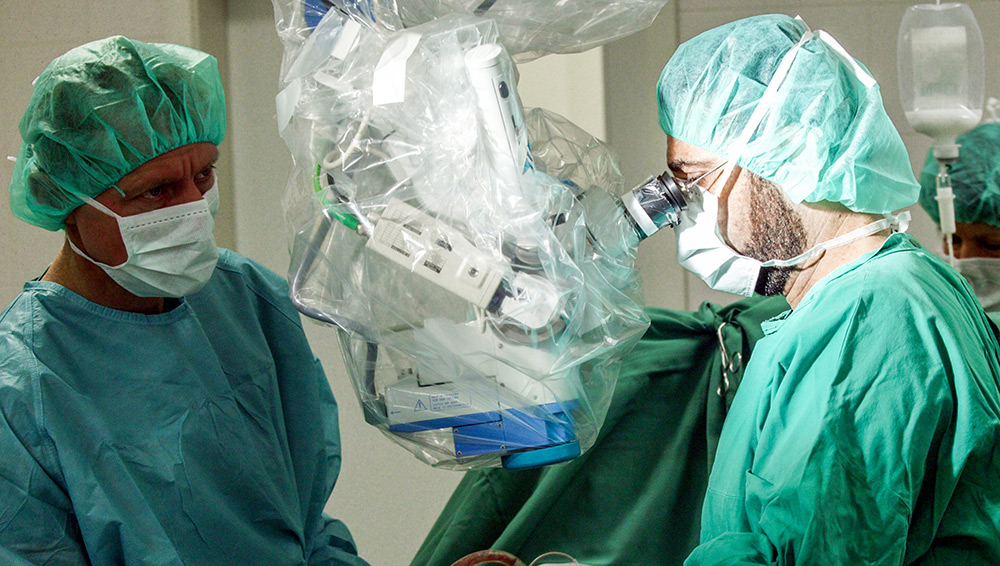What is a spinal lipomatosis?
Scan your body once - you may feel small lumps under the skin. These lumps are often lipomas. A lipoma is a benign tumor of fatty tissue that usually causes no symptoms. It is therefore also called a fat tumor. Based on lipomas, there is the term lipomatosis (Greek: lipos = fat; -om = tumor-like growth; -ose = chronic progressive disease).
Lipomatosis can affect different regions of the body. In some cases, this increased form of fatty tissue exists in a highly sensitive area called the epidural space. This is a space in the spinal canal, but outside the spinal meningeal space. This area usually contains fatty tissue, loose connective tissue, veins and lymphatic vessels. We speak of spinal lipomatosis when this fatty growth is located in the spinal canal of the spine. With the diffuse proliferation of fat cells, outgoing spinal nerves can be compressed, squeezed: Thus, spinal lipomatosis results in spinal canal compression and associated symptoms.
The causes for a spinal lipomatosis
Despite international research, modern science knows relatively little about the causes of spinal lipomatosis. The occurrence of lipomas can have different causes. Often it occurs without any identifiable cause, i.e. idiopathic. Other causes of spinal lipomatosis include:
- Cortisone use
- Cushing's syndrome: The clinical picture of Cushing's syndrome is the result of abnormally increased production of the adrenal hormone cortisol. The absolute majority of Cushing's disease is triggered by a benign tumor in the pituitary gland, which results in an overproduction of the hormone ACTH. This ACTH then stimulates adrenal hormone production, leading to an increase in cortisol in the blood.
- Obesity. In fact, a link is observed between overweight (obesity) and various pre-existing conditions. Most notably, these include diabetes and elevated uric acid levels.
- Patients who have successfully overcome organ transplantation and are now able to live a second life are also at risk of lipomatosis. Why? Because these people take medications (corticosteroids) to dampen the immune system, which in turn can have insidious side effects.
- Not to be underestimated as a cause of lipomatosis is a hereditary disease in which lipomas occur more frequently; the so-called neurofibromatosis. Neurofibromas and lipomas grow to such an extent that in some people the entire body is affected.
Symptoms of spinal lipomatosis - similar to a herniated disc
The disease of spinal lipomatosis may be asymptomatic. In some cases, there is back pain and pain in the spine with radiation to the legs or arms, possibly with muscle weakness, sensory disturbances or cramps. In other words, overall symptoms similar to those of a herniated disc or spinal stenosis.
There are patients who complain of so-called vegetative disorders, for example incontinence. Likewise, paralysis and rectal disorders can be symptoms of spinal lipomatosis.
Diagnosis of a spinal lipomatosis
As with all diagnoses, the diagnosis begins with a discussion between the physician and the patient, the so-called anamnesis interview. If pain, obesity, diabetes and possibly an organ transplant are confirmed, i.e. a synopsis of symptoms and complaints, the specialist may well suspect spinal lipomatosis. Mind you, however, only suspect.
The technique must speak a definitive clear language. This includes magnetic resonance imaging (MRI) when lipomas are suspected in the spine: in this imaging of the spine, an increase in epidural fatty tissue can be detected. Soft tissues such as connective tissue and fatty tissue, but also muscles, can be assessed very well in this imaging procedure.
Therapies for lipomas - lose weight or operate
If spinal lipomatosis is not treated, there is a high risk that it will progress. There are several options for the treatment of lipomas. In casual terms, one could say: lose weight or operate!
Weight reduction should be pursued if it is more or less obvious that the severe overweight has triggered or promoted the problem. It may also make sense to discontinue the cortisone medication. However, your specialist will have to weigh up the risks and benefits. In principle, it is important not to discontinue the cortisone abruptly, but to taper it off carefully.
If lipomatosis causes symptoms, surgical volume reduction is necessary. The removal is performed in the course of a microsurgical operation. Absolutely necessary and, above all, expeditious surgery is required in case of unbearable pain and restrictions, paralysis and bladder as well as rectal disorders. Surgery and removal of the lipoma can then help to reduce the pain.

The Avicenna Clinic in Berlin is always willing to help you
Since the year 2001, the Avicenna Clinic is based in Berlin. Our doctors have at least 25 years of international experience in their respective fields (neurosurgery, spinal surgery, anesthesia, and orthopedics).
If you have severe back pain, a herniated disc or a suspected herniation, please contact us using the following information:


